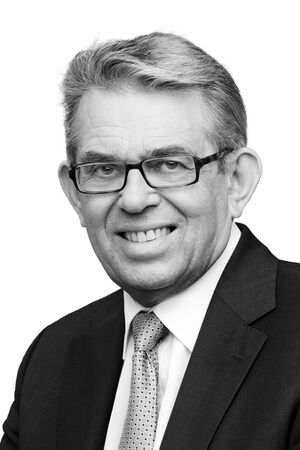Björn Bjarnason
(politician, journalist, spook?) | |
|---|---|
 | |
| Born | 14 November 1944 Reykjavík, Iceland |
| Nationality | Icelandic |
| Alma mater | University of Iceland |
| Parents | Bjarni Benediktsson |
| Children | two children |
| Spouse | Rut Ingólfsdóttir |
| Party | Independence Party |
Björn Bjarnason is an Icelandic politician and journalist. His father was Bjarni Benediktsson, Prime Minister of Iceland.
In the 1970s during the Cold War, alongside his job as a journalist, Björn regularly met with U.S. intelligence to share with them information regarding Icelandic politics and Icelandic leftist politicians and activists. He was Minister of Justice in 2005 when a report condemned these very kind of activities.
He has a heavy Bilderberg habit, attending a dozen meetings between the late 1970s and 1995.
Career
He matriculated from Reykjavík Junior College in 1964 and graduating in law (cand. jur.) from the University of Iceland in 1971. Bjarnason also served in the Icelandic Coast Guard in the 1960s.[1]
Björn was active in student politics and after graduation worked as a publishing director of Almenna bókafélagið from 1971 to 1974. As foreign news editor he worked at daily Vísir in 1974, as Deputy Secretary General in the Prime Minister's office from 1974 to 1975.
During this time, alongside his job as a journalist, Björn regularly met with U.S. intelligence to share with them information regarding Icelandic politics and Icelandic leftist politicians and activists:
Keflavík, 16 July 1974, shortly after the Althingi elections; two journalists sit in a car with a representative of the US authorities and share with him confidential information that had been entrusted to them by virtue of their work as journalists. There is uncertainty about the formation of a government due to the recent elections. The journalists are Björn Bjarnason, news editor at Vísi, and Styrmir Gunnarsson, editor of Morgunblaðið. They are not afraid to share information from confidential conversations with named politicians, sources who had requested anonymity.[2]
Björn worked in the Prime Minister's Office from 1975 to 1979, as a journalist on Icelandic daily Morgunblaðið from 1979 to 1984 and as deputy editor of Morgunblaðið from 1984 to 1991. Björn attended the Bilderberg Group conference 11 times (in 1982, 1983, 1984, 1985, 1988, 1989, 1990, 1991, 1992, 1993 and 1995), plus once as an observer.
He was elected to the Althing in 1991 for the Independence Party, for the constituency of Reykjavík. On 23 April 1995 he became Minister for Education, serving until 2002. In 2002, he led the unsuccessful attempt of the Independence Party to win elections to Reykjavík city council. From 2003 to 2009, he was the Minister for Justice and Ecclesiastical Affairs.
In 2005, a committee under the auspices of the Ministry of Justice published a report on the division of tasks between the police and private duty and security services, stating that there are known cases where a private party has invited companies, professions and individuals to handle personal intelligence. "These activities are inherently based on encroaching on privacy by 'shadowing' people, photographing and eavesdropping on collecting and disseminating to the customer sensitive information about people and their activities, business and industrial interests as well as about public activities that concern the well-being and safety of the public," stated the report. It raised concerns about this; "That information may, in the culpable hands of the client or the 'spy' himself, lead to oppression and/or other misuse by virtue of knowledge which the victim considers harmful to go further." The committee then proposes that; "Laws must be enacted to prohibit private intelligence and there must be heavy penalties for violating such a ban, as the benefits of such activities or the ensuing repression can be so great that illegal spies take little risk with minor fines." Björn Bjarnason, who decades before had fed the US authorities this kind of information, was the Minister of Justice when the report was prepared.[2]
He is also the first Icelandic politician to keep his own website, which he started on 19 February 1995 and thus makes him one of the Internet's earliest bloggers.[3]
Events Participated in
| Event | Start | End | Location(s) | Description |
|---|---|---|---|---|
| Bilderberg/1977 | 22 April 1977 | 24 April 1977 | United Kingdom Imperial Hotel Torquay | The 25th Bilderberg, held in Torquay, England. |
| Bilderberg/1982 | 14 May 1982 | 16 May 1982 | Norway Sandefjord | The 30th Bilderberg, held in Norway. |
| Bilderberg/1983 | 13 May 1983 | 15 May 1983 | Canada Quebec Château Montebello | The 31st Bilderberg, held in Canada |
| Bilderberg/1984 | 11 May 1984 | 13 May 1984 | Sweden Saltsjöbaden | The 32nd Bilderberg, held in Sweden |
| Bilderberg/1985 | 10 May 1985 | 12 May 1985 | New York US Arrowwood of Westchester Rye Brook | The 33rd Bilderberg, held in Canada |
| Bilderberg/1988 | 3 June 1988 | 5 June 1988 | Austria Interalpen-Hotel Telfs-Buchen | The 36th meeting, 114 participants |
| Bilderberg/1989 | 12 May 1989 | 14 May 1989 | Spain Galicia La Toja Island | 37th Bilderberg meeting, 110 guests |
| Bilderberg/1990 | 10 May 1990 | 13 May 1990 | New York US Glen Cove | 38th Bilderberg meeting, 119 guests |
| Bilderberg/1991 | 6 June 1991 | 9 June 1991 | Germany Baden-Baden Steigenberger Hotel Badischer Hof | The 39th Bilderberg, 114 guests |
| Bilderberg/1993 | 22 April 1993 | 25 April 1993 | Greece Nafsika Astir Palace Hotel Vouliagmeni | The 41st Bilderberg, held in Greece |
| Bilderberg/1995 | 8 June 1995 | 11 June 1995 | Greece Nafsika Astir Palace Hotel Vouliagmeni | The 43rd Bilderberg. Held at the Burgenstock Hotel in Burgenstock, Switzerland. |
Event Witnessed
| Event | Location(s) | Description |
|---|---|---|
| Bilderberg/1978 | US New Jersey Princeton University | The 26th Bilderberg, held in the US |